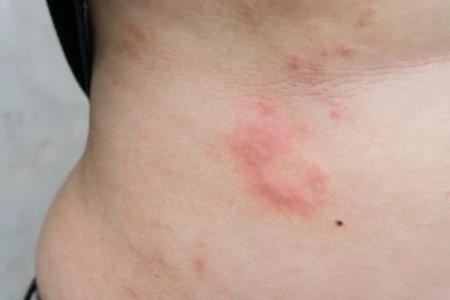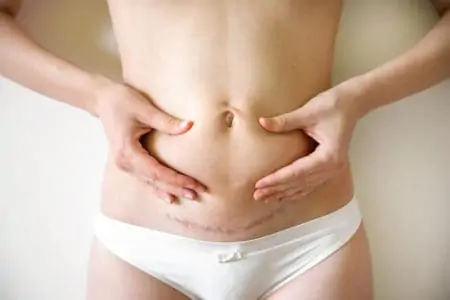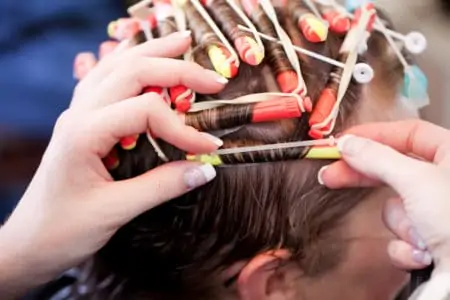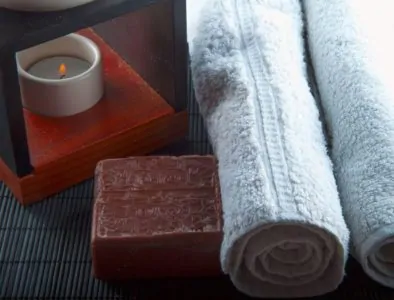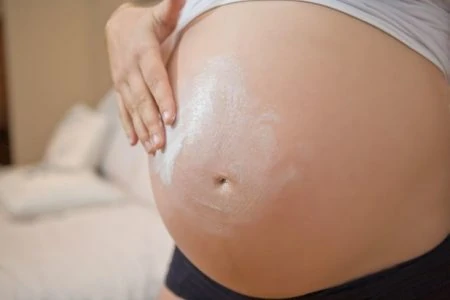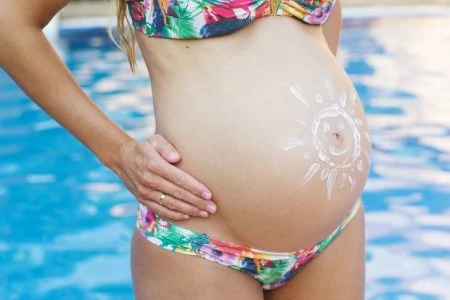When you think about pregnancy skin, one of the first things that often comes to mind is the pregnancy glow. But a healthy glow is not the only thing pregnancy can do to your skin.
It can also bring acne, stretch marks, and for some women, a painful and itchy rash known as PUPPP.
Let’s talk about what causes PUPPP rashes, what you can do about them, and when you can expect relief.
Key Takeaways
- PUPPP (pruritic urticarial papules and plaques of pregnancy) is a common, itchy rash that occurs during pregnancy, usually in the third trimester.
- The exact cause of PUPPP is unknown, but skin stretching, fetal cells, and an overworked organ system may contribute.
- PUPPP is generally harmless and goes away within weeks of the baby’s birth, but it’s important to see a doctor for an official diagnosis.
- To manage PUPPP, avoid scratching, use moisturizers, take oatmeal baths, and try antihistamines or steroids as recommended by your doctor.
What Is PUPPP?
PUPPP, short for pruritic urticarial papules and plaques of pregnancy, is an itchy but benign rash that occurs during pregnancy, usually in the third trimester. It’s fairly common, occurring in about 1 in every 160 pregnancies, and is more common in first-time moms and moms carrying multiples (1). Also, you might be more likely to experience PUPPP if women in your family had it.
The PUPPP rash typically begins in the stretch marks on your belly and looks like small pimple-like hives at the beginning (2). The rash is often red and patchy, closely resembling eczema. It is also extremely itchy.
Within a few days, it will spread to other parts of your body like your back, legs, thighs, buttocks, and arms. The good news? It never goes to your face for some reason. No one seems to know why, but we are grateful either way.
Your doctor might use any one of the names below to describe the same condition:
- Bourne’s toxemic rash of pregnancy.
- Toxic erythema of pregnancy.
- Nurse’s late-onset prurigo.
- Polymorphic eruption of pregnancy (PEP).
While some of these sound scarier than others, they are all the same condition.
Who Gets It?
There are several factors that seem to put certain women more at risk for PUPPP than others. These are some of the most common ones:
- Ethnicity: PUPPP develops at a higher rate in Caucasian women.
- Experience: Women experiencing first pregnancy are more likely to have PUPPP.
- Multiples: Those pregnant with multiples seem to have a higher risk for PUPPP, and those expecting triplets have a higher chance of developing PUPPP than those with twins.
- Baby’s sex: It seems to occur twice as often in women pregnant with a boy.
- Health factors: PUPPP is more common in those experiencing high blood pressure during their pregnancy.
While these scenarios might make you more likely to experience PUPPP, you could be one of the lucky ones who manages to avoid it. And women can still have PUPPP without any of these risk factors. PUPPP does not discriminate and can affect women of all nationalities and skin types.
And just when you think you might be in the clear, up to 15% of women who get PUPPP get it after their baby’s delivery.
Most importantly, despite the apparent discomfort, PUPPP is benign.
What Causes PUPPP?
No one knows exactly what causes PUPPP, but some studies show the following reasons may cause a woman to experience PUPPP while her friends do not.
1. Skin Stretching
When stress is put on the skin, causing it to stretch quickly, it can damage the connective tissue. This is what causes stretch marks, but it can also cause a PUPPP rash in some pregnancies.
This is why it’s more common for PUPPP to occur in women who are pregnant for the first time or are carrying multiples. The faster your skin stretches, and the more it stretches, the more damage occurs, and the higher the risk for PUPPP.
The same thing can happen in women with increased maternal weight gain during pregnancy because, consequently, they have more skin stretching.
2. Fetal Cells
Fetal cells can migrate to different parts of your body, including your skin. While sometimes this benefits the mom because it protects against certain diseases, your body can also look at these fetal cells as a foreign body it needs to fight against.
Some studies show that PUPPP rash is a reaction to the fetal cells that migrate to your skin. Fetal cells seem to migrate to the skin more often in women who are pregnant with boys, which would explain why 60% to 70% of PUPPP cases occur in moms who are carrying a boy (3).
3. An Overworked Organ System
The liver is our body’s main detoxification organ, while the kidneys are in charge of filtering out our blood. If your liver is overworked and unable to properly detoxify your body’s toxins, this can sometimes reveal itself in a skin rash or discoloration. The same can happen if the kidneys are having a hard time keeping up.
How Is It Diagnosed?
It’s important to see your doctor for an official diagnosis instead of assuming your rash is PUPPP. While PUPPP is generally harmless, other similar conditions can develop during pregnancy which are a lot more serious.
Conditions such as pemphigoid gestationis, which can be passed on to your baby, need to be ruled out (4). Intrahepatic cholestasis, which can also cause a rash, is a liver disease that can occur in pregnancy. It carries risks such as preterm birth, fetal distress, and even stillbirth (5). Your doctor will also exclude allergic reactions, some infections, and other less frequent possible causes of a rash.
Will It Require A Test
Can I Prevent PUPPP?
Unfortunately no, there is no way you can entirely prevent PUPPP from happening. That’s because we aren’t completely sure what causes it, and some things, like migrating fetal cells, can’t be prevented.
What you can do is make sure to eat a healthy diet, gain weight slowly and steadily, and try not to scratch as your skin stretches to prevent irritation. These things can help lower your risk for PUPPP.
Having PUPPP in one pregnancy does not mean you will or won’t have it again in your next pregnancy. If it does happen again, which is very rare, it will usually be milder than the first time.
Editor's Note:
Dr. Irena Ilic, MDTips for Managing PUPPP Skin Rash
The bad news is there is no definitive cure for PUPPP — all we know is it will usually go away within several weeks of your baby’s birth (6). But the lack of a cure does not mean you have to sit idly by while your body feels like it’s slowly being taken over by a colony of ants.
Below is a list of tried-and-true methods that can help gain some relief from the itching and help you maintain your sanity while dealing with PUPPP.
- Do Not Scratch: When you have an itchy area of skin, it’s normal for you to want to give it a good scratch. Don’t! Scratching only leads to damaging already stretched-out skin and will eventually make your rash worse.
- Antihistamines: Oral antihistamines can do a great deal to relieve the itching that comes with a rash like PUPPP. But while they are usually safe to take while pregnant, you should always talk to your doctor before deciding to take them, and discuss which one is right for you. Still, don’t expect wonders from these drugs as they are often only mildly effective (7).
- Oatmeal Baths: Oatmeal baths can help relieve itching and soothe and moisturize your skin. Its anti-inflammatory properties help calm irritated skin. For a DIY oatmeal bath, take one cup of oats and process it in a blender or food processor until it reaches a fine powder consistency. Then add it to a bathtub filled with warm — but not hot — water. If you don’t want to deal with the mess the ground oatmeal can leave, you can also wrap the ground oats in a cheesecloth or muslin bag and allow the water to run over it into the bath.
- Moisturize: Aloe vera, vitamin E, cocoa butter, coconut oil, and shea butter are all topical moisturizers that can help soothe your skin and stop the discomfort that comes with PUPPP rash. You should avoid moisturizers that contain fragrances since they can dry the skin. You should also avoid moisturizers that contain retinol, calamine, vitamin A, and salicylic acid since these ingredients have been known to cause birth defects.
- Steroids: Steroids can be an effective way to treat PUPPP rash, but it’s imperative you use them only with your doctor’s guidance. When you go to your doctor, they might first suggest a topical steroid cream with hydrocortisone to help the itching areas. If your rash continues to get worse, they might even prescribe a round of oral steroids to treat the condition more aggressively.
- Grandpa’s Pine Tar Soap: We don’t know why this soap works, but some moms swear by it. The best part is that it doesn’t only seem to help with the itching, but for some women, it helps make the rash disappear. For this treatment, wash the affected area and the skin around it three times a day. After bringing up a good lather with the soap, rinse it off with cool or lukewarm water. Moms who have used this method say they have seen the rash start to disappear in as little as three days.
- Cold Compresses: Cold temperatures can slow down the transmission of nerve signals to your rash, temporarily helping with the itching the rash can bring on. Simply soak a cloth in cool water, then lay it on the affected area. You can also soak it in cold milk for a compress that will help nourish the skin while it cools it.
- Soft Clothing: Nothing is more annoying than an itchy sweater against already aggravated skin. While dealing with PUPPP, choose soft and loose clothing. These will be more comfortable and won’t irritate your skin more than it already is. Try to wear cotton clothes as much as possible.
- Natural Anti-Inflammatories: Peppermint and chamomile are natural anti-inflammatories (8). When applied topically, they can give some relief to itchy and irritated areas. Combine the herbs with either aloe vera or unscented lotion and apply to your rash three times a day.
If your PUPPP rash requires taking medication, you will likely be on your treatment for a week or two, and possibly even after delivery. Make sure you discuss your treatment and how it may affect breastfeeding with your doctor.
Editor's Note:
Dr. Irena Ilic, MDFAQs
The Bottom Line
PUPPP can be painful, itchy, and irritating. If it’s happening to you, we understand how annoying it can be. We’ve been there, done that. We’ve know from experience that with a lot of patience and self-control, you will reach the light at the end of the PUPPP tunnel.
If you’re currently experiencing the discomfort that PUPPP can bring, remember that this is not forever. The rash will go away within weeks of your baby being born, and soon it will all be just a distant, albeit annoying, memory.
